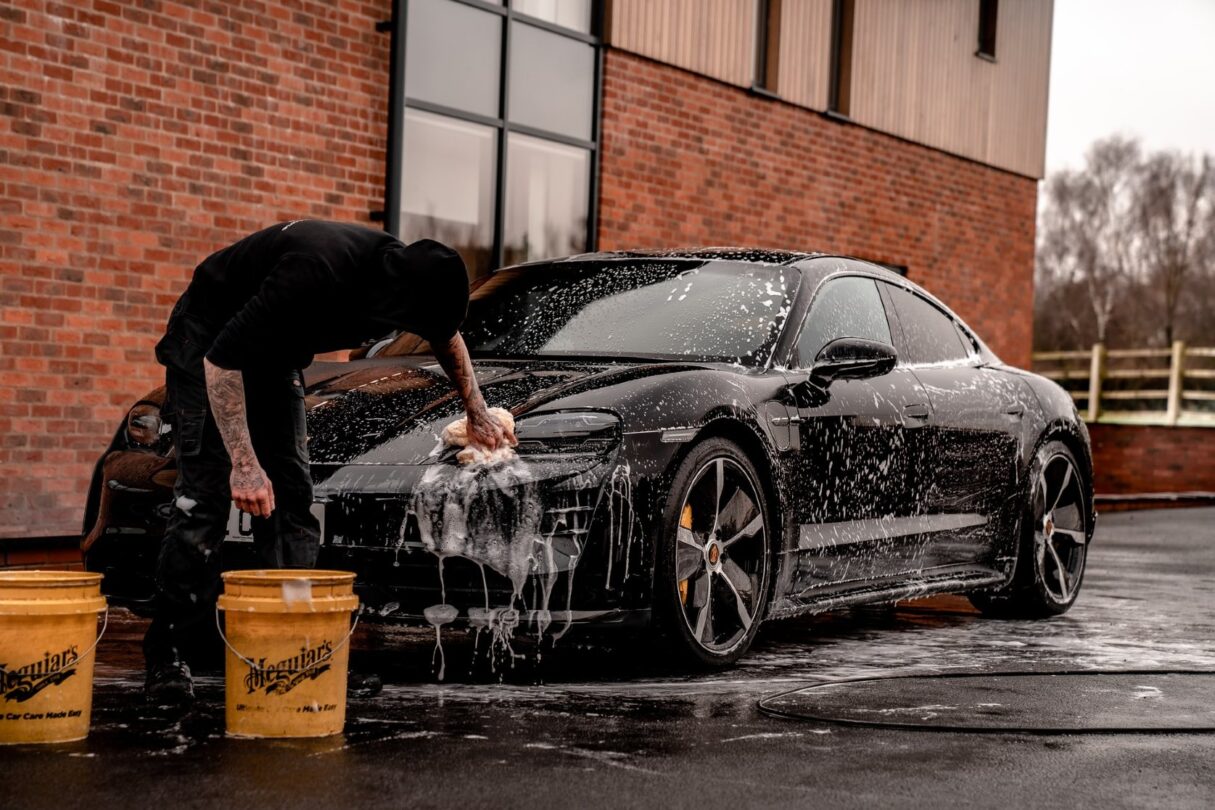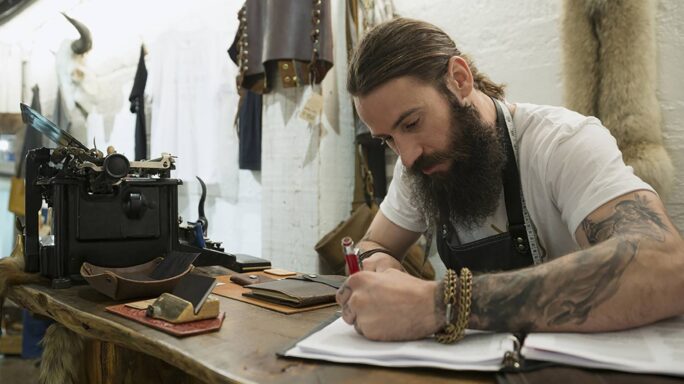Money Matters
Talasi’s Detailing: A fast and furious path to owning a mobile car detailing business
Talasi May, the founder of Talasi's Detailing, talks about managing his business on the go and shares top tips for future entrepreneurs.

For some people, running their own business is a target—a dream.
But for others, entrepreneurship and being your own boss comes naturally.
Since the age of 18, Talasi May has been detailing cars.
As the owner of Talasi’s Detailing, he’s been ‘valeting’ or ‘detailing’ cars, referring to a top-to-bottom professional deep cleaning of a vehicle, aiming to restore it to as near to new as possible.
Talasi offers mobile detailing services but has already grown to a stage where he’s invested in a detailing shop space.
Read on to find out what he’s learned about running a business where he’s constantly on the go.
Here’s what we cover:
- From cleaning cars as a hobby to building a portfolio of customers
- How Talasi got his first van
- How Talasi deals with his business finances
- What a typical day looks like for Talasi’s business
- What the future looks like for Talasi’s Detailing
- Expanding the business and delegating tasks
- Talasi’s three mobile takeaways to get you started
From cleaning cars as a hobby to building a portfolio of customers
When I was 18, I was supposed to go to university.
But after passing my driving tests and getting my first car, I found that I was cleaning cars as a hobby at the weekend alongside a full-time job—first mates, then neighbours, then friends of neighbours.
I built up a portfolio of customers, and there was enough demand there for me to invest in products, equipment, and training. It turned into a business naturally.
It’s not something I rushed into—I progressively built up the business.
I had to make sure there was still work, as I was renting a flat and needed to keep the income in there for bills.
Demand for mobile valeting can be a bit up-and-down depending on the weather.
So, I had to make sure the valeting work was there to begin with, and gradually, recommendations and word of mouth meant I was getting quite busy.
How Talasi got his first van
To begin with, I was working out of the back of my first car, a Vauxhall Corsa, relying on other people’s water and electricity.
In 2017, I bought an old 2005 Citroen Berlingo, in which I placed a water tank and generator.
Ideally, working mobile in detailing, people will use you more if you have your own water and electric supply as you can carry out the work anywhere and everywhere.
After around 18 months, I got a bigger van, which I got sign-written—that’s when you add your business name and contact details onto your vehicle.
I replaced the signwriting again on the van recently.
It’s well worth doing because it’s good free advertising that can help pick up leads simply driving to and from a job or getting supplies.
How Talasi deals with his business finances
I never borrowed money initially, unless you count about £1,000 from my dad for my first van, which I paid back when I sold my car.
I’ve been a hard worker since I first started at 18, even in my employed jobs.
I was always working overtime and that kind of thing, so I always brought in extra money, which I was putting back into equipment. Initially, I didn’t have a pressure washer or hoover, so I started with buckets.
I’m still in the mental startup mindset, so it’s about investing as much I can to get more in the future.
As the business developed full time, I had cash challenges ranging from monthly wages to how much money we made every day.
Looking back, I should have used software at the beginning.
For the first two years, I was writing new invoices every time, rather than using a template to fill them out, which was quite time-consuming.
I had to fill out the customer’s details from scratch each time before emailing it over.
Even if you used Word documents to create invoice drafts, you would still have to write details like the customer’s name, address, car, date of service, and price.
This could take you about 15 minutes, and then if you do more than four customers a day, it starts to take a long time.
I only started with software after speaking to a customer whose partner was an accountant. We had a conversation where I said it was a nightmare sending invoices.
I started to get behind sending invoices because of the time it was taking, and when I spoke to his partner, they said I needed software to cut the time to write up invoices—get a template filled up with details of the accounts on there already.
Everything, including the contact list, is already there.
So, you just input by adding the service and price, and off it goes.
So, in the last 18 months, I’ve been using software, making invoicing a lot easier. It has cut down the time I spent on invoices dramatically.
We use a Square card reader. Mainly it’s bank transfers because many customers only need to get set up on that once, which is easy.
Then you can send them an invoice.
You can see if the invoice has been delivered and viewed, whereas when you send an email, you sometimes get people saying they’ve missed it or it’s ended up in the junk folder.
I mainly use my laptop as I’m always doing things on it, and sometimes my phone.
Having software where you’ve got everything on there wherever you are, such as contacts, invoice details, and expenses, saves a lot of time.
What a typical day looks like for Talasi’s business
If I’m mobile for the day, I’m probably leaving about 7am or 7.30am to start at a customer’s house—they give you the keys, and you do the car.
I’d maybe do two or three jobs in a day.
You’d see the customer in the morning, and after you’ve finished. I then show the customer around the car once we are done and make sure they are happy with the work.
It’s as simple as that.
After a job, if it’s a regular customer, you’ll give them an invoice.
If it’s a new customer, they’ll pay through card payment, cash, or bank transfer, and you send them an invoice.
With the latter, we usually ask them to pay there and then, but I can arrange more lenient terms with regular customers.
I like working on cars that are in lovely locations.
Sometimes you’d be in hectic places where it can be a nightmare to park, but then you get the flip side—sometimes you’ll find yourself out in the countryside at a massive house.
It’s nice and quiet to be there, and you can have a chilled day.
I like carrying out a full valet—it’s satisfying.
The problem is with our industry is that some people don’t always want to pay out big money for the level of cleaning a vehicle might need.
Sometimes you are working to a budget, but other times it’s nice doing a big disaster detail job where it needs a lot of cleaning, and you have free rein to do what we want on it, and they get a lovely result.
I like doing jobs where you can do what you want and get the car looking the best it can be.
What the future looks like for Talasi’s Detailing
I’ve always invested back into the business, trying to see where it will go, keeping up to date with trends in the industry.
I’ve invested money into the detailing shop—selling products offline and online.
But since I’ve started on YouTube, I’ve noticed that more and more people are interested in detailing who didn’t know how or what to do or what products to use.
So, in the last six months, I’ve been doing up the shop/unit, tidying it and making it look nice and presentable because we’re opening a training academy because we feel there’s a gap in the market for it.
The academy will work well with the shop, as we offer a wide range of equipment, products, and brands which people can use for training.
It’s not just aimed at people who want to start a career in it. It can simply be enthusiasts that like cleaning their car and want to know precisely how.
Hopefully, people would want to come down, spend their money and do the training.
I felt that the shop could only go so big, but training can work well because it educates people and generates new, ongoing business—you can sell products offline and online off the back of it.
Expanding the business and delegating tasks
The training will mean I need to cut down on the time I spend on the actual primary valeting side of the business.
So, what I’m currently trying to get my head around is training someone else up and expanding.
Investing a bit of time and money over the next six months into an employee and then getting them up to a high enough standard to confidently go out in the mobile van and carry on without me.
I’ve been learning more about delegating my time.
Whether as a sole trader or self-employed, you end up taking a lot on because you’re getting paid an hourly fee, so it’s hard to bring someone else in early on.
I started on my own, so the customers know me, who has provided service from day one.
I think people might find it hard to pass that trust over to someone else, especially when they’ve been working with me for the last three or four years.
But the problem is there’s only a certain number of hours in the day.
As good as I am at valeting and detailing, I’m not so skilled at areas of the business.
Sometimes the best thing you can do is delegate that task to someone else and use that time on what you’re good at.
Talasi’s three mobile takeaways to get you started
1. You’ve got to stay on top of the finances
Making sure you put money back for taxes, overheads, bills, products, and some for reinvestment in products, equipment and training, as well as for personal use.
If you are serious, expect to spend a couple years constantly reinvesting back into it, not just money but time as well.
You’ll be working a lot of hours but it’ll be worth it in the end.
2. You can’t be in the trenches trying to do everything alone
What I’ve learned is to grow and do well you have to delegate things to other people.
If there are areas which you aren’t as good at, get someone who specialises in those things to do it for you. The time it’ll take you to learn could be better spent elsewhere.
For example, you might need to design and print business cards, but to do it yourself you might need software, experience, and time.
This could take hours.
Whereas you could invest your money into paying for someone else to do it, who’ll complete it a lot quicker and get a better result.
3. Make the most of social media
Without social media, I don’t feel we’d be anywhere near as big.
Someone could put a recommendation on Facebook, and then 10 people would tag your business in it if you’re reputable.
The more interaction you can get, the more sales you’ll make, and the more people will know your brand.
Be active and consistent on social media as much as you can.







Ask the author a question or share your advice